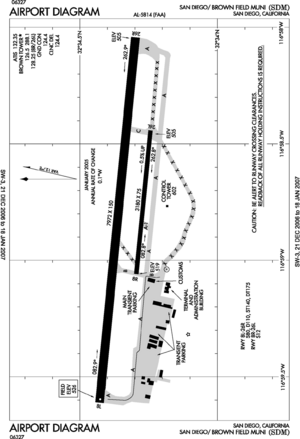Brown Field Municipal Airport facts for kids
Quick facts for kids
Brown Field Municipal Airport
|
|||||||||||||||
|---|---|---|---|---|---|---|---|---|---|---|---|---|---|---|---|
 |
|||||||||||||||
| Summary | |||||||||||||||
| Airport type | Public | ||||||||||||||
| Operator | City of San Diego | ||||||||||||||
| Serves | San Diego, California | ||||||||||||||
| Elevation AMSL | 526 ft / 160 m | ||||||||||||||
| Coordinates | 32°34′20″N 116°58′49″W / 32.57222°N 116.98028°W | ||||||||||||||
| Website | www.sandiego.gov | ||||||||||||||
| Runway | |||||||||||||||
|
|||||||||||||||
Brown Field Municipal Airport (IATA: SDM, ICAO: KSDM, FAA LID: SDM) is an airport in the Otay Mesa area of San Diego, California, United States. It is about 13 miles (21 km) southeast of Downtown San Diego. The airport is named after Commander Melville S. Brown, a US Navy officer who died in a plane crash in 1936.
The main runway at Brown Field is 7,972 feet (2,430 m) long. The airport's official codes are SDM (from the FAA) and SDM (from the IATA). Brown Field was once a military base called Naval Auxiliary Air Station Brown Field. Today, it is a public airport that helps reduce air traffic at larger airports. It also serves as a port of entry from Mexico, meaning people can enter the U.S. here. Sometimes, customs officers are available if pilots ask the FAA.
Contents
The History of Brown Field Airport
Brown Field is located about 1.5 miles north of the border between the U.S. and Mexico. The airport first opened in 1918 and was called East Field. It was named after Army Major Whitten J. East. The U.S. Army started an aerial gunnery (shooting from planes) and aerobatics (fancy flying) school here. This helped ease crowded conditions at Naval Air Station North Island. Major East was a pilot in World War I and died in an accident in 1918.
From 1918 to 1919, pilots learned to fly planes like the Curtiss JN-4D Jenny at East Field. After World War I, the military kept control of the field. They used it for quick landings and for experiments with radio-controlled target drones.
Brown Field During World War II
In 1943, the U.S. Navy took over the airfield and renamed it NAAS Otay Mesa. Later that year, it was renamed again to NAAS Brown Field. This was to honor Commander Melville S. Brown, who died in a plane crash in 1936.
Between 1943 and 1946, during World War II, the U.S. Army Air Forces, the U.S. Navy, and the U.S. Marine Corps used NAAS Brown Field for training. They trained with many different aircraft, including:
- Lockheed P-38 Lightning
- Grumman F4F Wildcat
- Grumman TBF Avenger
- Grumman F6F Hellcat
- Consolidated PB4Y-2 Privateer
In 1946, the Navy closed NAAS Brown Field and gave it to San Diego County. The county rented parts of the old base for a chicken farm. Chula Vista High School was even started on the airport property in 1946.
Brown Field During the Cold War
In 1951, the Navy reopened the airfield as NALF Brown Field. This was because military activity increased during the Korean War and the Cold War. In 1954, Brown Field became a Naval Auxiliary Air Station again. It had facilities to support regular flights, missile programs, and practice landings for aircraft carriers.
In 1955, NAAS Brown Field was home to several Navy squadrons and units. These included utility squadrons, anti-submarine warfare squadrons, and a missile unit. The next year, it hosted two utility squadrons and was the headquarters for Commander, Utility Wing Pacific. Many types of aircraft operated here, such as:
- Grumman F6F Hellcat
- F9F Cougar
- Douglas C-47 Skytrain
- Douglas A-26 Invader
- P2V Neptune
- FJ Fury
On November 2, 1954, a special plane called the Convair XFY Pogo made a unique flight at NAAS Brown Field. It took off straight up, flew horizontally, and then landed straight down. In 1957, Brown Field was chosen as a site for one of the Project Vanguard Earth Satellite Tracking Stations. These stations tracked early satellites.
Brown Field Becomes a Public Airport
On September 1, 1962, the Navy closed NAAS Brown Field for good. They gave ownership of the airport to the City of San Diego. A key condition was that it must remain a public airport.
In the mid to late 1960s, Pacific Southwest Airlines (PSA), an airline from San Diego, trained its pilots at Brown Field. They used planes like Piper Arrows and Beechcraft Bonanzas. PSA also trained pilots for the German airline Lufthansa at Brown Field. In 1970, Lufthansa moved its training to Phoenix, Arizona.
Nearby Airports
Tijuana Airport is a large airline airport just over 1 mi (1.6 km) south of Brown Field. It is across the Mexico-United States border. Tijuana Airport has a similar runway length and a slightly different runway direction (09 / 27).
Airport Surroundings
Planes cannot use a precision approach to land on either runway at Brown Field. This is because there are mountains (up to 3,600 feet high) less than six miles (10 km) east of the airport. Several plane accidents have happened because pilots flew too low over these mountains, especially when flying at night using visual flight rules (VFR).
Past Incidents
While flying is generally very safe, there have been a few notable incidents near Brown Field:
- On March 16, 1991, a plane that left Brown Field crashed into Otay Mountain. Sadly, ten people were involved in the incident.
- On August 16, 2015, two planes collided in the air about 2 miles northeast of Brown Field. A twin-engine jet and a single-engine Cessna 172 Skyhawk were involved. The Cessna's pilot was practicing touch-and-go-landings when the planes touched wings above Otay Mesa. Both planes caught fire when they hit the ground. Pieces of the planes fell a quarter-mile apart and started small fires in the area.
See also
 In Spanish: Aeropuerto Municipal Brown Field para niños
In Spanish: Aeropuerto Municipal Brown Field para niños

